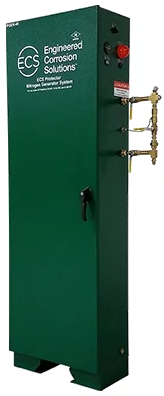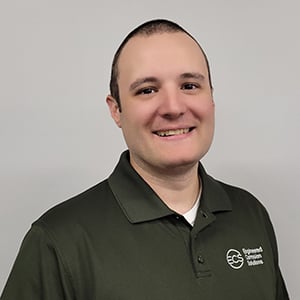Generator troubleshooting guide
When new technology is introduced into an industry, it tends to be viewed with a certain level of skepticism. In the fire protection industry, the introduction of nitrogen generators as a method to control corrosion was no different.
Initially, fire sprinkler contractors and building owners were reluctant to believe that the simple introduction of nitrogen in place of compressed air would control corrosion and prevent dry and preaction fire sprinkler systems from developing pin-hole leaks. Additionally, many fire sprinkler fitters reacted with concern when seeing a nitrogen generator in the field for the first time — they believed it would be too complicated to operate and maintain.
Fortunately, with ECS nitrogen generators that is not the case. In fact, the term nitrogen generator is somewhat of a misnomer. A nitrogen generator might be better described as a nitrogen filter — it is simply taking a compressed air stream and filtering out the oxygen and other trace gases to produce a nitrogen-rich gas source.
If a fire sprinkler contractor or building owner can operate a dry or preaction system with an air compressor, they will have no problem installing, operating, and maintaining a nitrogen generator. Even so, some issues can still arise.
Troubleshooting your nitrogen generator
Here are seven tips for troubleshooting the two most common concerns when dealing with nitrogen generators:
Problem 1: I think my air compressor is running too much.
Tip #1: With nitrogen generators it is important to understand that the nitrogen separation technology requires that a portion of the air that the compressor is producing be blown off as waste gas. Therefore, the compressor will run longer to produce a fixed amount of nitrogen than it would to produce the same amount of compressed air.
Tip #2: The process of performing Dry Pipe Nitrogen Inerting on a dry or preaction fire sprinkler system requires that the initial oxygen in the pipe network be purged through the system vent. During the purging period – which is typically fourteen (14) days or less – the nitrogen generator will run more frequently to replace the oxygen gas that is being removed from the system through the vent.
Problem 2: My dry or preaction system is not reaching the target nitrogen purity.
Tip #3: We test and configure our nitrogen generators to produce nitrogen gas with a purity of 98%. This process requires that the regulators inside the nitrogen generator be configured to maintain a certain pressure differential across the nitrogen separation membrane. If these regulators are adjusted in the field by non-qualified personnel, it could affect both the nitrogen purity and the nitrogen production rate, resulting in a reduction of nitrogen purity. To verify the purity of gas being produced, use a handheld gas analyzer connected to the sample port on the generator while it is running.
 Tip #4: The oxygen removal vents that are installed on the dry or preaction system have a fixed orifice that controls the gas discharge rate. Due to the size of the orifice it is possible for debris to obstruct the gas flow path and restrict the ability of the vent to remove oxygen from the system.
Tip #4: The oxygen removal vents that are installed on the dry or preaction system have a fixed orifice that controls the gas discharge rate. Due to the size of the orifice it is possible for debris to obstruct the gas flow path and restrict the ability of the vent to remove oxygen from the system.
Tip #5: A water trap created by a low spot in the pipe network that is full of water will isolate all piping downstream and prevent the oxygen from being removed by the vent. If the gas sample point is downstream of the water blockage the nitrogen purity rate will be low.
Tip #6: Nitrogen separation technology can be affected by contaminants in the compressed air being supplied to the nitrogen generator. ECS nitrogen generators are equipped with an air filtration system that prevents these contaminants from reaching the nitrogen separation membrane. The filters in the nitrogen generator must be replaced at least annually and more often in excessively dusty or dirty environments. Not performing the recommended filter maintenance could result in the nitrogen separation membrane being permanently damaged.
Tip #7: ECS vents are equipped with a relief pressure regulator to prevent the accidental depressurization of the fire sprinkler system. In a properly configured installation the vent regulator would be set at or slightly above the low air alarm pressure. Once the system pressure drops below the regulator set point gas is prevented from exiting the vent even if the vent is in the open position. If the regulator is set above the pressure setting of the air maintenance device, the system will not vent properly and oxygen will not be removed from the system.
Still have questions about nitrogen generators?
ECS nitrogen generators and vents have been meticulously designed and built to minimize the chance of equipment failure. By installing all equipment, including vents and gas sampling in the riser room, ECS equipment is easier to install, operate and maintain than any other nitrogen generator manufacturer serving the fire protection industry. Our simple space saving designs are the solution of choice for many fire sprinkler contractors and building operators.
To learn more about our approach corrosion management technology — including steps for selecting a generator, an air vent, and corrosion monitoring equipment — download our guide to nitrogen generation systems below.


